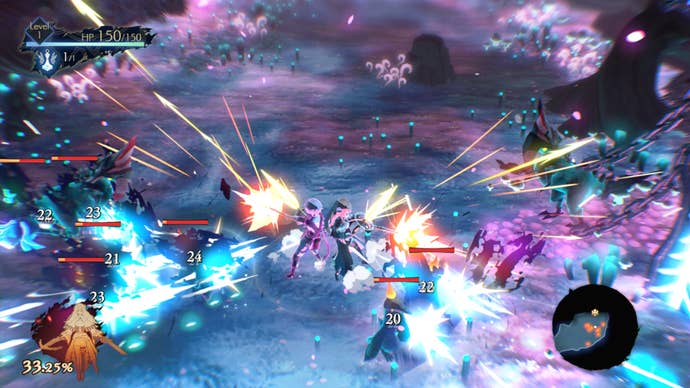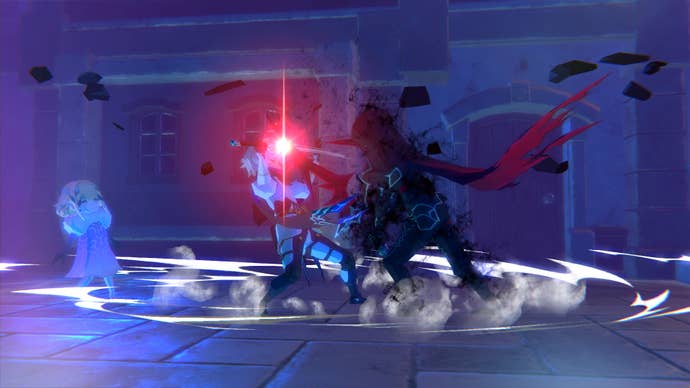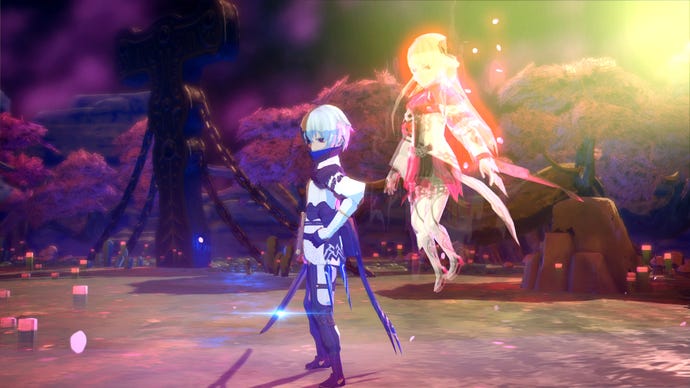Tokyo RPG Factory on How the Studio's Classic RPG Inspiration Fuels the Action-RPG Oninaki
Don't worry, Oninaki is still going for that classic JRPG feeling. Just in a less obvious way.
This article first appeared on USgamer, a partner publication of VG247. Some content, such as this article, has been migrated to VG247 for posterity after USgamer's closure - but it has not been edited or further vetted by the VG247 team.
There's a part in I Am Setsuna that really feels old school, but in a delightful sort of way. If you sail your airship to a small, previously undiscovered island and enter it, you'll find a mysterious pixelated town. It's vibrant in its color scheme too-pretty much the opposite of the pale snow that masks the rest of Setsuna's world. When you talk to the jarring 16-bit NPCs that live in the town, you quickly find they are the developers themselves. They all charmingly thank you for playing their game, with a quip or two.
"So the reason why, or the idea I guess, of that secret town is that past Final Fantasy titles that [supervisor Takashi] Tokita-san had worked on had those kind of developer rooms," director of I Am Setsuna, Lost Sphear, and the upcoming Oninaki, Atsushi Hashimoto, tells me at E3 2019 this year. Developer rooms are easter egg areas, once upon a time a lot more common in games, that are filled with characters based on the game's developers themselves. The secret developer room in I Am Setsuna is indicative of the guiding principle of the studio: making games that feel like the late and great JRPGs of the 1990s.

It was 2015 when Square Enix officially unveiled Tokyo RPG Factory. Its first game I Am Setsuna landed in 2016. The immediate successor was Lost Sphear in 2017 (released in 2018 in the U.S.), which shared the same art style-though it was far more colorful than Setsuna-and Chrono Trigger-like battle system. Tokyo RPG Factory's new game looks mighty different though, adopting a more anime aesthetic and, shockingly, action combat.
From the looks and sounds of its new project Oninaki, Tokyo RPG Factory is perceived to be moving away from that studio-founding idea. Its lead developers assure me that it's anything but.
"That basic ideology hasn't really changed," says Ryutaro Sasaki, producer of Oninaki, through a translator. "So the fun feeling of RPGs that you had in the 90s, we feel that that doesn't change, like even if you play the game now it still feels fun. And we wanted to bring that kind of game to this era, and we did change from a turn-based RPG to an action-RPG with this time around, but that core idea hasn't changed at all."
In Oninaki, the player embodies Kagachi, a Watcher who helps guide lost souls to their end goal of being reincarnated. In combat, Kagachi lends his body to Daemons, which gives him the ability to switch between combat styles-a stark contrast from the studio's first two games' use of an Active Time Battle combat system. The Daemons in Oninaki essentially possess the player, and each Daemon offers up a different weapon and new actions to use in turn.
The team notes that Oninaki is heavily influenced by hack-and-slash games of the 90s in its general combat flow, but when I follow up to ask if there were any specific titles of influence, they say they mean more in a general sense. Director Hashimoto likens the moment-to-moment beats of Oninaki's action-focused combat to a job system.
"When we first started this project, we had the concept of having a protagonist protect the heroine all by himself throughout the entire game, and it was actually thought of being a turn-based RPG at that time," he says. "But when we thought that you will be playing as a protagonist alone, then we thought that maybe it would be fine for that protagonist to be able to change jobs, and then when we thought further we felt that maybe being able to change jobs in real time and also incorporating that into an action-RPG, that might be a more fun experience for the players. That's where it all came about."
It's not just the combat that's dramatically changed for Tokyo RPG Factory's new title though. It's the art style too. While its characters retain a similar general build-that sort of half-chibi thing-their faces are more defined now. Their outfits and designs look more, well, anime too. As creative producer Takashi Tokita tells me, it was necessary to set Oninaki apart from Tokyo RPG Factory's previous titles, and also to give the studio a different sort of challenge.

"Since Lost Sphear was kind of like a direct continuation of Setsuna, it was in that same kind of visual approach, but we did not really want to do the same thing three times in a row," says Tokita. The Final Fantasy and Chrono Trigger veteran Tokita was a supervisor on both I Am Setsuna and Lost Sphear, but Oninaki is the first game in which he is creatively involved with at a large capacity. "We wanted a little bit more challenge for ourselves. [...] It might be influenced by the Japanese anime and anime culture, but it's also something that I believe that our visual creators were able to create something that was unique to them and something that only they could do as well."
Oninaki may not be a direct descendent of Chrono Trigger like how I Am Setsuna and Lost Sphear billed themselves to be, but it's a fresh step for the retro-minded modern RPG studio. We'll see if the anime-infused new look and style of Tokyo RPG Factory feels as 90s-esque as it hopes when Oninaki launches on August 22 for PC, PlayStation 4, and Nintendo Switch.


